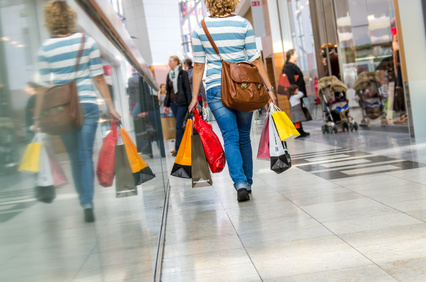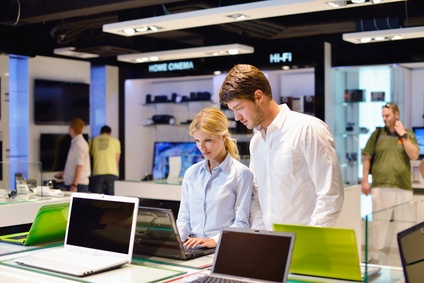Despite what you may have heard, the high street is alive and kicking. In fact, 90% of all consumer purchases still take place in-store, according to a new white paper produced by Field Marketing Agency, Channel Advantage.
Their report, which reveals UK consumers will spend £88.4bn in Q4 2013 (£1.95bn more than 2012), explores how technology continues to shape modern consumer habits, and why brands must utilise the power of experiential practice to improve in-store shopping experiences and ultimately, continue to grow sales.
Do we still need shops?

To borrow Mark Twain's much beloved epitaph, “News of my death has been greatly exaggerated”.
People have been heralding the death of the high street for years, but the reality is it stubbornly refuses to die. So what is it that consumers loyal to the high street and how can retails continue to capitalise on -and create- new trends?
Current challenges
Despite the doom and gloom of the pundits, traditional bricks and mortar retailers are still perfectly positioned to benefit enormously from the huge changes sweeping the industry.
When it comes to consumer electronics for example, 70% of spending still goes through shops, and despite the recent high profile failures of high street retailers such as Comet, Blockbuster and HMV, the fact is, there's no real sign of a shift in the fundamental need for people to touch and feel products before buying.
What is changing is the way consumers conduct their purchasing cycle, driven to a huge extent by the rise of new technologies.
A survey of 5,570 UK shoppers found that 76.7% of consumers prefer to shop in-store (Retail Eyes). However, the challenge facing both major brands and the bricks and mortar retailers is how to optimise their channel offerings so as to take advantage of the opportunities that this provides. This means doing away with outmoded ideas of customer purchasing, and introducing genuinely innovative multichannel marketing strategies which deliver a consistent experience and message at every touchpoint.
Five things brands should be doing to take advantage of the changing face of retail
- Identify specific products in your sector which may be vulnerable to comparison shopping by analysing shopping habits over a period.
- Use customer loyalty services and other incentives to appeal to shoppers at the point of sale.
- Focus attractive pricing offers on your most vulnerable products, which are typically big ticket items.
- Use technology to fight technology. Digital coupons and one click express checkout are examples of the kind of thing which works.
- Make use of evangelist and specialist staff sales teams to provide added value to shoppers at the point of sale
But as high street chains continue to drop left, right and centre, how can businesses survive?
Making most of digital
Once upon a time your customer walked through the front door, browsed the products and made their way to a cash register with their choices. Nowadays the front door has been replaced by a multitude of different digital touch points, each requiring different and yet complementary strategies. But just because a customer now starts their journey using a laptop or smartphone does not mean there should be two approaches to satisfying their needs.
 Research shows customers who use both online and in-store channels reported to spend 36% more than single-channel shoppers (Source Intel). The answer seems to be to replace the cold empty experience of traditional store floor browsing with a more dynamic and interactive experience.
Research shows customers who use both online and in-store channels reported to spend 36% more than single-channel shoppers (Source Intel). The answer seems to be to replace the cold empty experience of traditional store floor browsing with a more dynamic and interactive experience.
Global brands like Apple and Microsoft, report this field marketing agency, are pioneering this new approach with retailers such as Dixons in the UK, but it takes time and investment in staff training, technical infrastructure and cultural change to make it work properly.
The traditional bricks and mortar stores of tomorrow are less likely to be static shelf based spaces and more of a sophisticated environment where sales staff act as trusted advisors to guide the shopper to not just the best choice of products but also buying channels. This is particularly true where the product requires more explanation such as in consumer technology, where pile 'em high, sell 'em cheap is slowly giving way to a more nuanced approach to customer satisfaction.
Optimising the consumer experience
An optimised in-store experience entails a seamless relationship, allied with best of breed sales staff interaction, along with important features such as identical online and offline pricing, a similar if not identical product choice in every channel and opportunities for the customer to select their optimum purchase process instore, whether it be via a cash register or their mobile phone.
The most successful retailers of this age have adopted to the change by delivering best of breed interactions with their customers at every point. The journey may begin with a search engine, a social network link or a friend's recommendation, but in each case the winners present a clear and appealing route to the checkout, with as few hurdles in the way as possible.
Examples of optimised customer experiences
Click and Collect and Virtual Showrooming are just two features which point to the modern approach to customer satisfaction en route to the checkout. Massive online retailers such as Amazon have definitely benefited from this trend in recent years, but now the bricks and mortar outlets are fighting back with more appealing point of sale interaction, and improved checkout procedures to entice the customer to purchase immediately. In their recent article, 15 stats that show why Click and Connect is important to retailers, Econsultancy reveals 79% of consumers have used click-and-collect in the past year, while just under a quarter of survey respondents said they would avoid making a purchase if the delivery options didn’t suit them.
The result of all this is that stores are now maximising their customer interaction areas and reducing the space given over for basic product display, along with using virtual displays and interactive shop windows to entice shoppers to experience the brand in a more direct way.
The power of people over digital

At the heart of all this technology however, lies the comforting human touch, which remains a large and crucial part of the equation. The major feature that seems clear from the current state of the industry is the growing importance of face to face marketing as an added value customer service and brand differentiator.
Intelligent use of in-store marketing and evangelism, coupled with a seamless experience whether online or offline will ensure that retail and the major brands that power it, will continue to provide the customer with improved choice, flexibility and ease of use as technology improves and systems become more powerful.
The future of retail: in a nutshell
There may well be significantly fewer retail outlets in the coming years, but the ones that remain will provide the kind of service oriented customer environment that today is largely just a pipe dream. It's a brave new, exciting world, and one where the digitally empowered customer solidifies their position as the king of the marketing tree.







